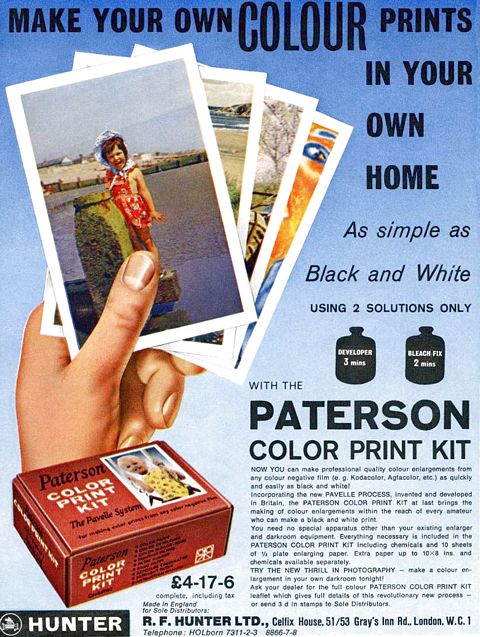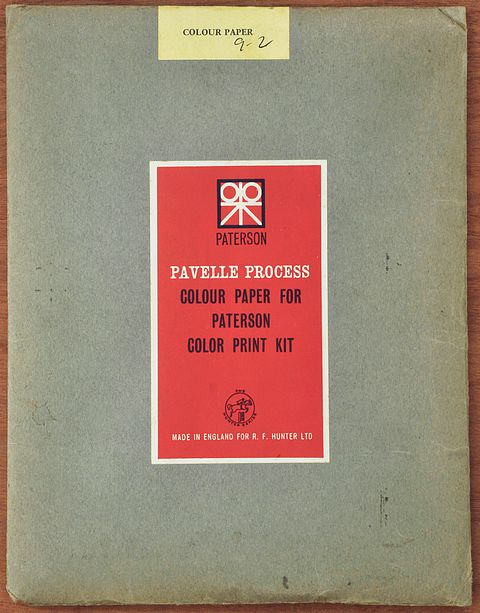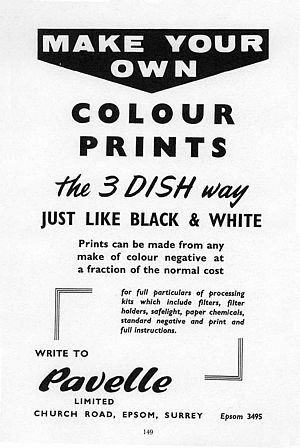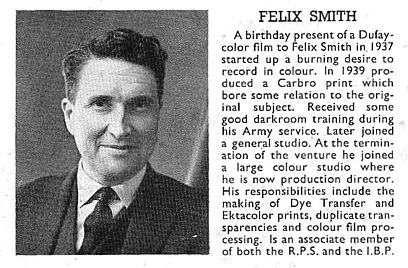| History of the Paterson-Pavelle Process |
|
|
|
|
| Thanks to an e-mail (June 2005) from Dr.Richard Pavelle, President of Invent Resources Inc. at Lexington, Massachusetts (son of Leo Pavelle ~ see Frank Omilian's story), I have managed to piece together some of the history of the Paterson-Pavelle home colour printing system, distributed in the UK by R.F.Hunter from 1963. | ||||||||||||||||||||||||||||||||||||||||||
|
to the 1970s sale of Pavelle to the Italian Durst organisation. |
can be read here |
|||||||||||||||||||||||||||||||||||||||||
|
|
|
|||||||||||||||||||||||||||||||||||||||||
|
Michael Talbert has found the advertisement shown here: He says "An early advert for a Pavelle colour printing kit. It is believed the advert pre-dates the Paterson kit and it’s definitely not Pakolor. It’s taken from “Colour Photography for the Amateur”, by M.Lillington Hall, 1962, 3rd Edition. The advert probably dates from 1961 to 1962, in between the end of marketing the original Pakolor kits and the start of the Paterson-Pavelle kits distributed by R.F. Hunter. It may be exactly the same process as in the colour advertisement shown below (but it can't be known for certain)". Perhaps the early take-up of this process by amateur darkroom workers was slower than expected and prompted Pavelle (UK) Ltd to approach R.F.Hunter to act as distributors and so provide a boost to the market penetration of their home colour print processing kit. Hence, by December 1962 (see following paragraph), R.F.Hunter took on the marketing of the Pavelle kit, linking it with the well known and respected Paterson darkroom equipment & chemicals branding. In December 1962, the Paterson Colour Print Kit, "backed by the R.F.Hunter Organisation" was announced in an advertisement from Shaftesbury Photo Centre, Dorset (Ref: A.P. 26th Dec.1962), price £4.19s = £4.95p (incl. postage & packing) for a January 1963 delivery. |
||||||||||||||||||||||||||||||||||||||||||
 |
Paterson-Pavelle Introduction The following text describes how Dr.Jacobson (Dr.Jacobsohn) and his Photo-Chemical Co Ltd were responsible for originating the Paterson-Pavelle home colour printing process which was marketed in the UK by R.F.Hunter (Paterson distributors) from 1962 (P-100 chemicals and paper) and by Johnsons of Hendon from 1967 (P-200 chemicals and paper). Left is shown an early advertisement for the newly announced Paterson Color Print Kit, by the distributors R.F.Hunter, in Amateur Photographer magazine's 'Christmas Presents Number', dated 4th December 1963. "NOW YOU can make professional
quality colour enlargements from any colour negative film (e.g.
Kodacolor, Agtacolor, etc.) as quickly and easily as black and
white ! The kit was priced at £4.17s.6d (£4.88p) complete, including tax.
To view a processing
table for Pavelle Paper, |
|||||||||||||||||||||||||||||||||||||||||
|
The technical originator of the colour printing process that became known as Paterson-Pavelle was the same man, Dr.Jacobson, who originated the 1950s Pakolor home colour processing film and materials. Patents in the name of Kurt Jacobson are viewable at the European Patent Office website. There are 18 patents relating to colour film, colour printing paper, colour developing and colour printing technology over a (near) 20years span, though on two occasions there is also named Mr Keith Aston and on one occasion Mr Gerald Noel White. By the late 1960s, another co-inventor is Ralph Eric Jacobson, Kurt's son. Kurt's son became Professor Ralph Jacobson, ASIS HonFRPS. He was President of the Royal Photographic Socity (RPS) from 2005-2007. Professor Jacobson has been in touch and has provided me with further historical information of his father's work, which I have transcribed into a web page accessible by clicking here. Keith Aston is the named inventor of a number of colour printing patents throughout the 1960s while working for Pavelle Ltd and continued to patent ideas in the mid-1980s for Pavelle's new owners, Durst. Martin Hadden, who worked for Ilford from 1970 to 2009, previously worked at Pavelle, in Epsom, on their colour paper. He says "I was responsible for all the photo testing of the product and I worked directly with Dr Kurt Jacobson and Dr Ralph Jacobson. I got to work directly with Leopold Godowsky for a couple of weeks when he was at Epsom evaluating the colour paper for the investors who funded the building of the Pavelle coating plant in Caldwell New Jersey, USA". |
||||||||||||||||||||||||||||||||||||||||||
|
Contents of the earliest
Paterson Color Print Kit, as from 1962 to 1965. The Bleach Fixer consisted of two powder components below the red box marked Bleach Fixer. Part A was a white powder, Part B was a brown powder. The kit made up one litre each of Color Developer and Stop Bath, and 600ccs of Bleach Fixer. This was working solution, not to be diluted further. The packet of “Colour Paper for Paterson Color Print Kit” contained 10 sheets of 4¾ x 6½ inch paper (half-plate size), normal contrast grade, with a glossy surface. The safelight filter was an olive-green colour. The paper supplied in the kit was of a type suited to making prints from unmasked colour negatives. A 'basic filter' was required when making prints from masked colour negatives. In the instruction booklet, there was an instruction not to use the 'basic filter' (see below) when printing from Agfacolor, Adoxcolor, Gevacolor and Ferraniacolor unmasked negative films. The basic filter was required when printing from Kodacolor and Ilfocolor negatives. When using the Pavelle Theilgaard
Calculator to calculate exposure times: The Paterson Pavelle
Basic Filter It is thought most likely that the filter was used to correct for an otherwise heavy cyan/green cast when printing from masked negatives onto a paper balanced for unmasked colour negatives (the same would apply with Agfacolor CN III colour paper). The heavy cyan/green cast would be caused by the orange/red mask of a Kodacolor-X, Ektacolor, or similar masked colour negative. When comparing the Basic Filter against various Kodak Colour Printing filters, in the “CP” series, a direct match could not be found, but an approximate match was 15 Yellow and 60 Cyan, made up of the Kodak Colour Printing filters 5 Yellow and 10 Yellow, plus 10 Cyan and 50 Cyan (15 – 60). |
||||||||||||||||||||||||||||||||||||||||||
 |
||||||||||||||||||||||||||||||||||||||||||
|
Contents of the later
Paterson Color Print Kit, marketed by Johnsons of Hendon. Apart from the change from P-100 to P-200 chemistry and paper, another change when Johnsons became distributors was the inclusion, 'free', of the book by Felix Smith called "Making Pavelle Colour Prints with the Paterson Colour Print Kit", though by 1968 the name 'Pavelle' in the book title had disappeared. This book had been available previously, but was originally sold separately by R.F.Hunter at 10s/6d (52.5p). Michael Talbert comments that "The last chapter is on making inter-negatives from colour transparencies - very advanced stuff! I wonder how many amateur photographers were making colour inter-negatives from their transparencies in 1964 ? Very few, I should imagine !" The book was written by Felix Smith, (see his picture, below). He also wrote a regular article covering all technical aspects of colour photography in 'Photography' magazine during (at least) 1966 - 1968. It was called 'Felix Smith on Colour'. |
||||||||||||||||||||||||||||||||||||||||||
|
In 1962, Felix Smith had already authored the Focal Photo Guide book, "All about Printing Colour Negatives". It was priced at 2s/6d (12.5p). The picture of Felix, to the left, and a short biography, appear on the back cover of this book. He was keen on photography from the age of 6. Other interests included 16mm cine filming. |
||||||||||||||||||||||||||||||||||||||||||
 |
||||||||||||||||||||||||||||||||||||||||||
|
Information relating to Gerald White appears on the Open University website (born 1891, died 1963). Mr White was a chemist, a Fellow of the Institute of Chemistry and, in his latter years, Director & Research Manager at Photo-Chemical Co Ltd and finally Research Director at Pavelle Ltd. Kurt Jacobson began patenting his ideas on colour printing materials from 1953, this being the date of his earliest patent application, but his original research must have started many years earlier (possibly prior to WW2). Throughout much of the 1950s Mr Jacobson is named as Director of Photo-Chemical Co. Ltd, initially at Film House, Wardour Street, London, W.1; but later at Church Road, Epsom, Surrey. |
||||||||||||||||||||||||||||||||||||||||||
|
Dr Richard Pavelle recalls how Kurt Jacobson made some breakthroughs in colour paper technology and, in consequence, became involved with Richard's father, Leo Pavelle, around 1957. Together they worked to develop a facility in New Jersey (at the US Pavelle Corporation) to produce the colour paper. There was also an intention to produce a machine enabling home colour printing, but that was for the future (see the footnote to this web page for more information about that project). One of Jacobson's patents, GB963603, applied for in December 1961 by Pavelle Ltd, describes a combined colour printing and processing machine). Pakolor had some experience of this, having bought out a semi-automatic rollhead colour printer for the photo-finishing trade by 1959. The association of Kurt Jacobson of Photo-Chemical Co Ltd and Leo Pavelle of the Pavelle Corporation resulted in the Pavelle brothers (Leo and Simon) buying (?) the Photo-Chemical Co Ltd to secure Kurt Jacobson's expertise, and they set up a UK subsidiary, Pavelle Ltd, in Epsom, Surrey, being the same address as the previous Photo-Chemical Co.Ltd. This is believed to have occurred around 1960. Kurt Jacobson, Gerald White, Keith Aston and others, continued to work in the UK on manufacturing colour paper, processing chemicals and equipment and by December 1961 Kurt Jacobson is again filing patents, but he is now working for Pavelle Ltd, a British company at Church Road, Epsom, Surrey, UK. The Jacobson/Pavelle Ltd patents continue throughout the 1960s to early 1970. One patent, in 1968, names the Pavelle Corporation of White Plains, New York, where Kurt Jacobson is named as assignor of the invention (for speeding up colour material developing) to the Pavelle Corporation (US3372030).
There seems little reason to doubt that the above chronology of events charts the development of the Paterson-Pavelle home additive colour printing process, including the paper, chemicals and what seemingly became the simple but effective Pavelle-Theilgaard colour exposure calculator contained within the Paterson colour printing kit. This device would seem to have its roots in the Photo-Chemical Co Ltd patent GB748712, applied for in July 1953, with the complete specification being published in May 1956. Since Kurt Jacobson was (by then) a British citizen and Pavelle Ltd was a British company, Paterson's claims for their home colour processing kit being solely a British invention seems well founded, though assistance from the US Pavelle Corporation is inherent in their name being part of the Paterson-Pavelle process. The Paterson home colour printing outfit was given fresh publicity from 1967 when Johnsons of Hendon took over the distribution from R.F.Hunter. The January 1968 edition of 'Photography' magazine, in their 'News Desk' feature, proclaims the 'New' Paterson Colour Print Process, but this seems a late announcement for the same 'new' kit advertised at the same price in Amateur Photographer, April 1967, p70. There were claims for Paterson's improved Colour Paper (P-200) and its P-200 chemicals having increased processing capacity. A total processing time of 8minutes was claimed. Alongside is an advert from Amateur Photographer for 30th October 1968 where a new paper surface is announced, Art Stipple. The 'new' kit cost £5.5s (£5.25p, though this increased to £6.1s.10d = £6.10p by autumn 1968) including 25 sheets of Paterson P-200 colour paper (post card size, but available in sizes to 15"x12" i.e. 38cm x 30.5cm). The kit included 1 litre of colour developer, stop bath & bleach fix, plus printing filters, filter holder, exposure calculator, safelight filter and instruction manual. Processing was claimed to take between 5 & 8 minutes at a temperature range between 65°F and 85°F (18°C to 29°C) using only three processing baths. It was claimed the chemical solutions could be safely stored for 'months'. |
||||||||||||||||||||||||||||||||||||||||||
| Paterson-Pavelle Printing Papers for the P-100 and P-200 Processes | ||||||||||||||||||||||||||||||||||||||||||
|
The Paterson-Pavelle P-100 process was a faster version of the Pakolor colour print process, omitting the first wash and Hardener-Stabilizer bath. If it was required to dry or glaze prints by heat, after the P-100 process, the print was given a 30 second immersion in a 10% formalin solution followed by a wash of 5 minutes. This was sufficient to harden the emulsion for subsequent heat drying. A formula was given in the booklet entitled 'Paterson Colour Print Kit' (as was included in the kits dating from 1967). The kits packed in the red box from 1962 included a Stop Bath. The Stop Bath chemicals were included in the box marked 'Pavelle Process, Color Developer'. The later P-200 kits containing the Developer and Stop Bath were marked 'Developer, Stop Bath'. An instruction sheet enclosed in a packet of the Pavelle colour paper intended for processing in Pavelle P-100 chemicals, can be downloaded here. This instruction sheet probably dates from 1963 or 1964, but the date uncertain. The P-100 process chemicals were contained in the Paterson Colour Print Kit sold in a red box (see pictures near the top of this page). The instruction sheet bears a similarity to the Pakolor Type FC instructions. A 1968 (3rd rev) book by J. Coote entitled “Colour Prints” published in 1968, contains the statement “The colour paper marketed by Paterson is a direct descendant of earlier papers devised and manufactured by Dr. Kurt Jacobson. The earlier version of the paper and the process were first handled by Pakolor and later by the 'F.R. Corporation' before being taken over by Pavelle. The paper is now known as Paterson Colour Paper and is being distributed by Johnsons of Hendon.” The likely chronology of the
Pakolor / Pavelle printing papers is: As far as is known the F.R. paper was never sold in the UK. |
||||||||||||||||||||||||||||||||||||||||||
 |
 |
|||||||||||||||||||||||||||||||||||||||||
| An instruction from a packet of Paterson Colour Print paper intended for the P-200 process (white box kits; see further above), can be downloaded here. This instruction sheet dates from around 1967. | ||||||||||||||||||||||||||||||||||||||||||
 |
 |
|||||||||||||||||||||||||||||||||||||||||
| Processing Procedure for Paterson Pavelle Colour Paper using the Paterson Colour Print Kit | ||||||||||||||||||||||||||||||||||||||||||
|
The P-100 and P-200 processing procedures were identical. It is believed that the only difference was the chemical formulae. The Paterson Colour Print Kits date from 1962 to 1968, with the Process P-200 chemical kits dating from 1966. By 1969 the kits had been withdrawn from the market, and at that time there were no equivalent kits for the amateur to expose and process colour prints in a “home” darkroom. The following procedure was for dish processing, or for processing prints in the “Goodman” tank (perhaps the earliest amateur 'tank' processor for colour prints) First three steps to be carried out in total darkness or under a “Pavelle” Safelight screen. The screen was a dark olive green colour.
Notes.
|
||||||||||||||||||||||||||||||||||||||||||
|
FOOTNOTES: Editor's Notebook; Colour
Prints We have had news from the Pavelle Corporation in the U.S.A., of an automatic table model colour printer which can be used in daylight and produce a colour print in five minutes from the time of insertion of a colour negative. The P-100 Daylight Color Printer-Processor accepts colour negatives from 35mm. to 2¼ inch square, and by a built-in optical and masking system, a print either 2½ x 3½ or 3½ inches square is produced, it being possible also to enlarge a portion of the largest size negatives if required. A row of press-buttons at the side of the machine controls the filtration and exposure given each time. The filtration is worked out by a simple (in use) zeroing system, this and the exposure taking about two minutes, with a further three minutes for the actual processing cycle within the body of the P-100. When the print emerges, it just has to be washed for from 2-8 minutes and then dried. Finish! All this is possible because of the printing paper used, which has been worked out by two British scientists, Dr.K.I.Jacobson (known here in connection with Pakolor and its simple processing), and Dr.E.M.White (this might be a mis-print and may refer to Gerald White - see above). It is possible to use the Pavelle P-100 for processing only, using pre-exposed paper (from a conventional enlarger) and the use of this new paper in larger sizes in a normal darkroom sounds a predictable and attractive possibility for the near future. Full production of this new Printer Processor is expected in the USA before the end of the year, but we have so far (July 1962) no news of it being available here. Then, in October 1962, in the Photo-Digest pages of PhotoGuide Magazine: The Pavelle P-100 colour printer recently introduced in America yields finished colour enlargements from colour negatives within three minutes. It works in normal daylight, and is an extensively automated exposing and processing system. This was developed partly in America, and partly (the special colour paper and processing solutions) in England. The printer takes negatives from 24 x 36 mm up to 2¼ X 2¼ inches, and yields 2½ x 3½ or 3½ x 3½ inch prints. The printing side consists of a fixed-focus enlarger with three lenses for the different magnification ratios. A photoflood lamp provides the illumination, which is filtered by a pair of variable filters to adjust the colour balance of the print. A built-in photo-electric cell system measures the light transmission and automatically determines the correct filtration for a properly balanced print. It is then only necessary to expose for the indicated time. The printer takes a special colour paper in 9 foot rolls, 3½ inches wide. The unit feeds the paper into the focal plane of the enlarger, cuts off the exposed print, and passes it through the processing section, with the aid of motorized rollers. Processing takes place in a light-tight compartment containing a colour developer and a bleach-fix bath. The finished print emerges three minutes later, and only needs a short wash to make it permanent. The developer and bleach-fix baths are replaced after every dozen or so 3½ x 3½ inch prints. This only involves pulling out the plastic processing compartment and recharging with fresh solution. |
||||||||||||||||||||||||||||||||||||||||||
|
|
|
|
|
|
||



 The Paterson Pavelle
kit shown below is complete, apart from chemicals and paper,
and dates from around 1967. It used P-200 chemicals and paper.
Shown are two prints made by Michael Talbert using this kit.
Both of the kits illustrated here are owned by Michael Talbert.
The P-200 paper was still colour balanced for printing from unmasked
negatives, so the 'Basic Filter' would have been required with
an increasing number of colour masked negative films by the late
1960s e.g Kodacolor-X and Agfacolor CNS.
The Paterson Pavelle
kit shown below is complete, apart from chemicals and paper,
and dates from around 1967. It used P-200 chemicals and paper.
Shown are two prints made by Michael Talbert using this kit.
Both of the kits illustrated here are owned by Michael Talbert.
The P-200 paper was still colour balanced for printing from unmasked
negatives, so the 'Basic Filter' would have been required with
an increasing number of colour masked negative films by the late
1960s e.g Kodacolor-X and Agfacolor CNS.

 The
last Jacobson patent that names the Photo-Chemical Co Ltd is
dated July 1957. The 1950s was when the Photo-Chemical Co.Ltd
were manufacturing the
The
last Jacobson patent that names the Photo-Chemical Co Ltd is
dated July 1957. The 1950s was when the Photo-Chemical Co.Ltd
were manufacturing the